Extraterrestrial liquid water
Water observed in volcanic activity can provide more compelling indirect evidence, as can fluvial features and the presence of antifreeze agents, such as salts or ammonia.In June 2020, NASA scientists reported that it is likely that exoplanets with oceans may be common in the Milky Way galaxy, based on mathematical modeling studies.[16][17] Because the temperature at the base of the polar cap is estimated at 205 K (−68 °C; −91 °F), scientists assume that the water may remain liquid due to the antifreeze effect of magnesium and calcium perchlorates.While previously believed to be localized, most likely in a portion of the southern hemisphere, evidence revealed in 2015 now suggests the subsurface ocean is global in nature.[21] In addition to water, these geysers from vents near the south pole contained small amounts of salt, nitrogen, carbon dioxide, and volatile hydrocarbons.Mimas, another moon of Saturn similar in size and orbit to Enceladus, was found by Cassini to have a "rocking" motion whose amplitude could only be explained by a large subsurface ocean.[10] Ceres appears to be differentiated into a rocky core and icy mantle, and may have a remnant internal ocean of liquid water under the layer of ice.The signatures of surface water on terrestrial planets may be undetectable through thick atmospheres across the vast distances of space using current technology.Seasonal flows on warm Martian slopes, though strongly suggestive of briny liquid water, have yet to indicate this in spectroscopic analysis.Research suggests that in the past there was liquid water flowing on the surface,[40] creating large areas similar to Earth's oceans.In an article in the Journal of Geophysical Research, scientists studied Lake Vostok in Antarctica and discovered that it may have implications for liquid water still being on Mars.That wobble indicated that the moon's icy crust didn't extend all the way to its core — instead, it rested on a global ocean, the researchers concluded.[48][49] Material from Enceladus' south polar jets contains salty water and organic molecules, the basic chemical ingredients for life," said Linda Spilker, Cassini's project scientist at JPL.[2] Emissions of water vapor have been detected from several regions of the dwarf planet Ceres,[50] combined with evidence of ongoing cryovalcanic activity.[54] Anomalies in the orbital libration of Saturn's moon Mimas combined with models of tidal mechanics led scientists in 2022 to propose that it harbours an internal ocean.[64] Of particular interest in these cases is the fact that the models indicate that the liquid layers are in direct contact with the rocky core, which allows efficient mixing of minerals and salts into the water.A global layer of liquid water thick enough to decouple the crust from the mantle is thought to be present on Titan, Europa and, with less certainty, Callisto, Ganymede[64] and Triton.[75] Among the 1,235 possible extrasolar planet candidates detected by NASA's planet-hunting Kepler space telescope during its first four months of operation, 54 are orbiting in the parent star's habitable 'Goldilocks' zone where liquid water could exist.[77] On 6 January 2015, NASA announced further observations conducted from May 2009 to April 2013 which included eight candidates between one and two times the size of Earth, orbiting in a habitable zone.[citation needed] Lunar maria are vast basaltic plains on the Moon that were thought to be bodies of water by early astronomers, who referred to them as "seas".NASA's Goddard Institute for Space Studies and others have postulated that Venus may have had a shallow ocean in the past for up to 2 billion years,[85][86][87][88][89] with as much water as Earth.The Dawn space probe found possible evidence of past water flow on the asteroid Vesta,[93] leading to speculation of underground reservoirs of water-ice.The Opportunity Mars rover photographed bright veins of a mineral leading to conclusive confirmation of deposition by liquid water.[97] On 9 December 2013, NASA reported that the planet Mars had a large freshwater lake (which could have been a hospitable environment for microbial life) based on evidence from the Curiosity rover studying Aeolis Palus near Mount Sharp in Gale Crater.Nevertheless, on 10 December 2014, scientists reported that the composition of water vapor from comet Churyumov–Gerasimenko, as determined by the Rosetta spacecraft, is substantially different from that found on Earth.[101][102] The asteroid 24 Themis was the first found to have water, including liquid pressurised by non-atmospheric means, dissolved into mineral through ionising radiation.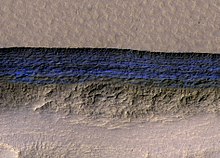
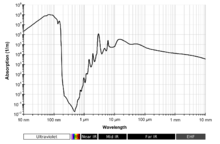




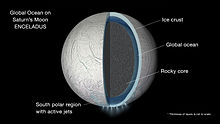


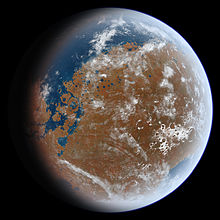

Exoplanets potentially containing water (artwork; 17 August 2018)
[
104
]
(Left to right:
Kepler-22b
,
Kepler-69c
,
Kepler-452b
,
Kepler-62f
,
Kepler-186f
.)
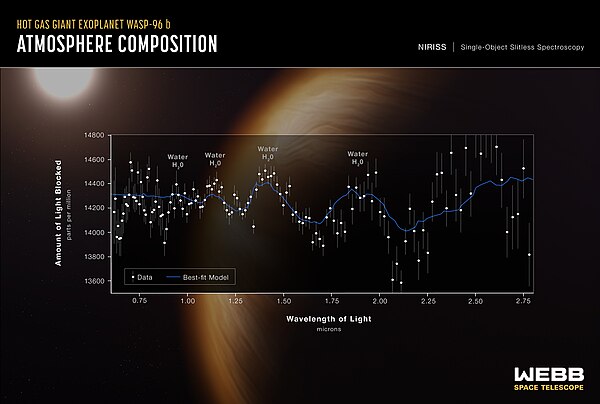

liquidextraterrestrial lifecelestial bodiesSolar SystemhydrosphereoceanicEarth's atmospheric pressurecircumstellar habitable zoneorigin of Earth's waterabsorption spectroscopygeochemistrywater vaporastronomical spectroscopywater on terrestrial planetstidal theoryplanetary differentiationradiometryvolcanicfluvialantifreezeammoniagroundwaterdwarf planetsplanetary systemslist of extrasolar candidates for liquid waterNASA scientistsexoplanetsMilky Way galaxymathematical modeling studiesbiochemistryabiogenesisoxygenhydrogenWater on terrestrial planets of the Solar SystemWater on MarsMars ocean theoryice capsvapourpascalsrecurring slope lineaeItalian Space Agencysubglacial lakesouthern polar ice capperchloratesEuropatidal flexingEnceladusCassini spacecrafttidal fluxGanymedeJupiterHubble Space Telescopedifferentiatedmantleinternal oceanwater icehydratedcarbonatesAhuna Monscryovolcanicice giantUranusNeptunesupercriticaldwarf planethabitableextrasolar planetary systemssample biasdetection methodsSeasonal flows on warm Martian slopesGJ 1214 bmagnetic fieldGroundwater on MarsThomas Goldliquid waterunder the surfacestream bedsspectroscopic measurementerodedmineralsGoethiteJournal of Geophysical ResearchLake VostokChaos terrainGeysersSaturnmicrobial lifesubsurface oceanorbital resonanceMartian subglacial water bodyCassini probedielectric permittivityMARSISMars ExpressPlanum Australe55 Cancri esupercritical fluidsupercritical waterradioactive decayTitaniaOberonTritonphases of iceMOA-2007-BLG-192Lbasteroid beltCallistoclass IIGliese 581 planetary systemGliese 581cGliese 581dgreenhouse effectGliese 581eGliese 667 CGliese 667 CcKepler-22bKepler space telescopehabitable zonesKepler-438bKepler-442bKepler-440bsuper-EarthCircumstellar diskKuiper beltOrigin of water on EarthinterferometryMWC 480